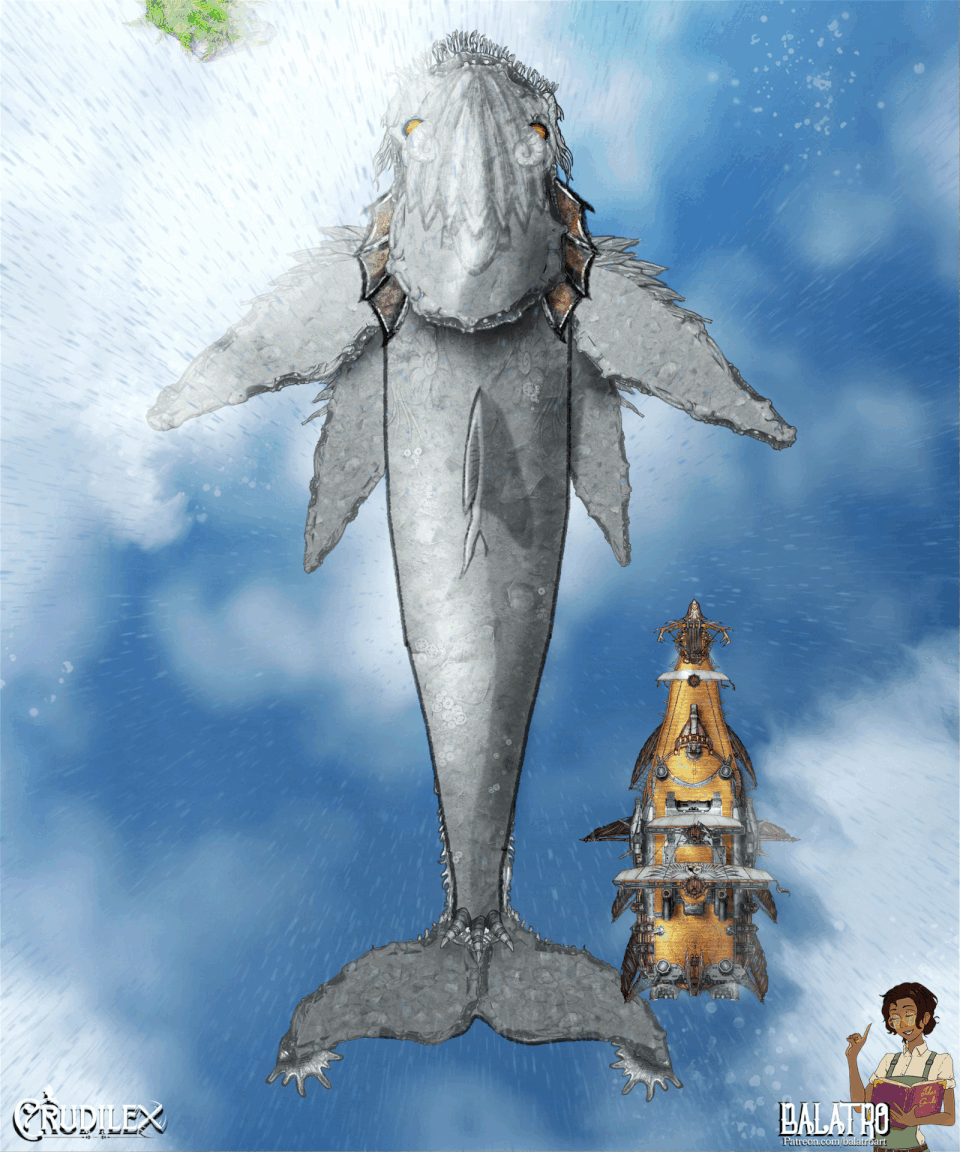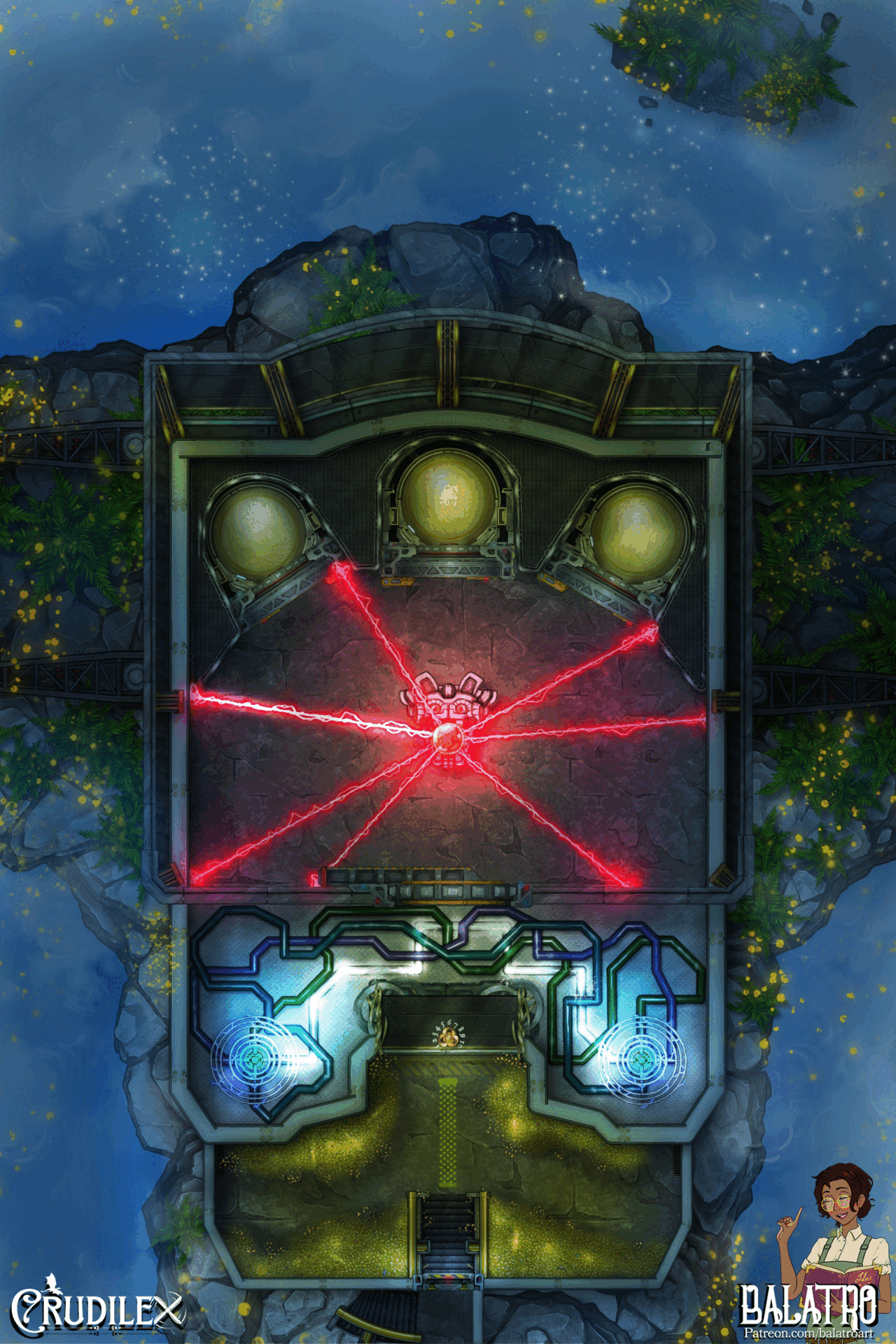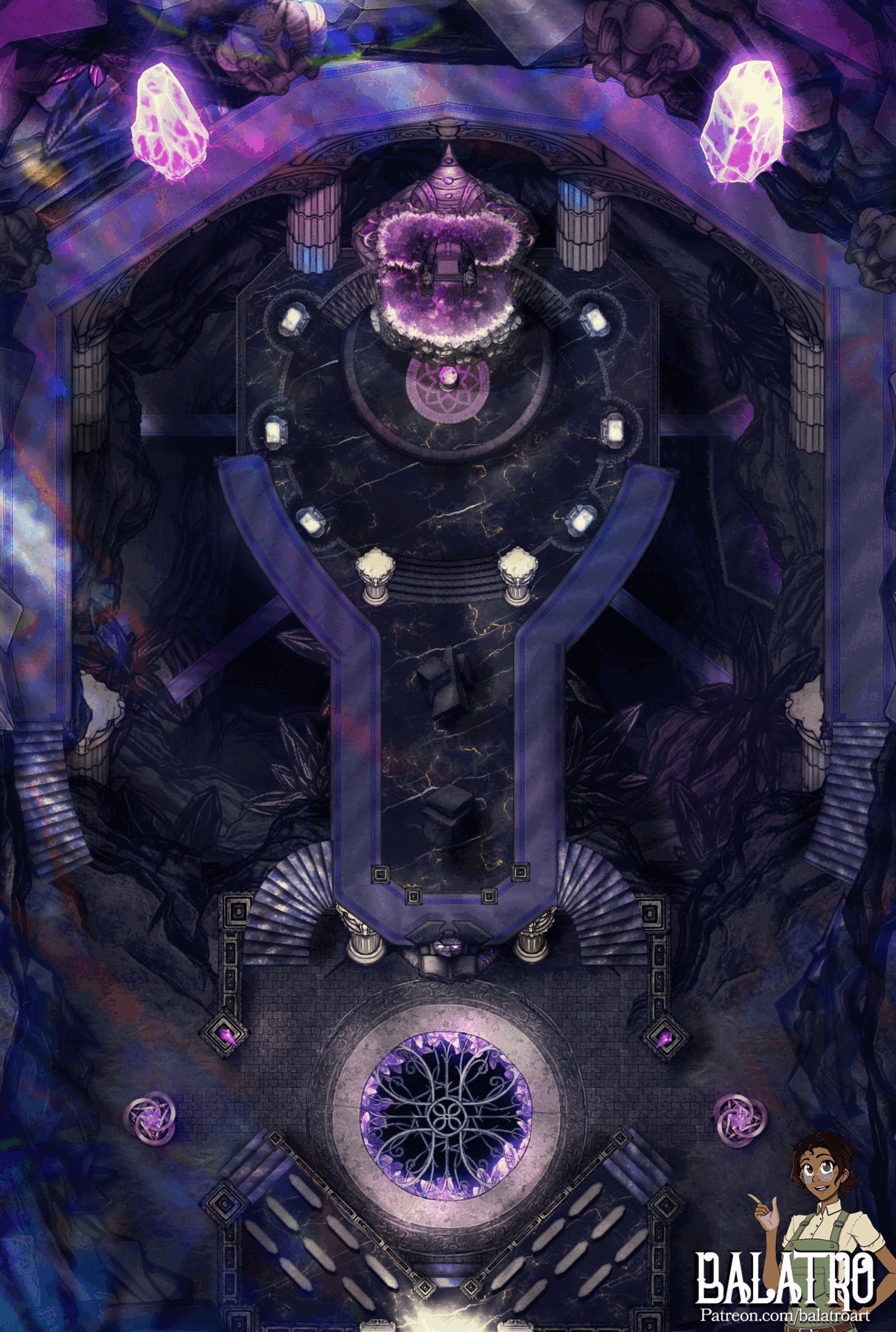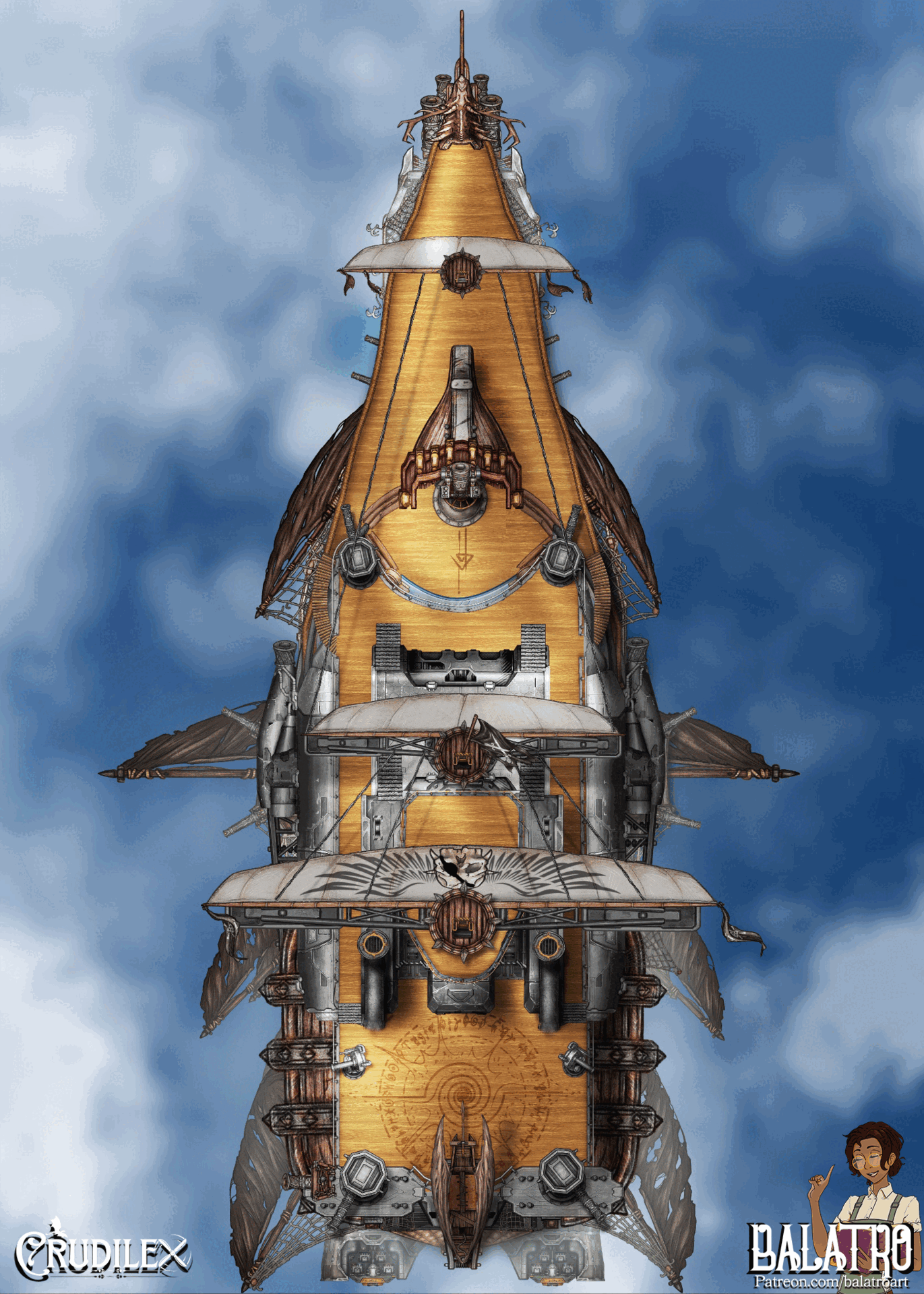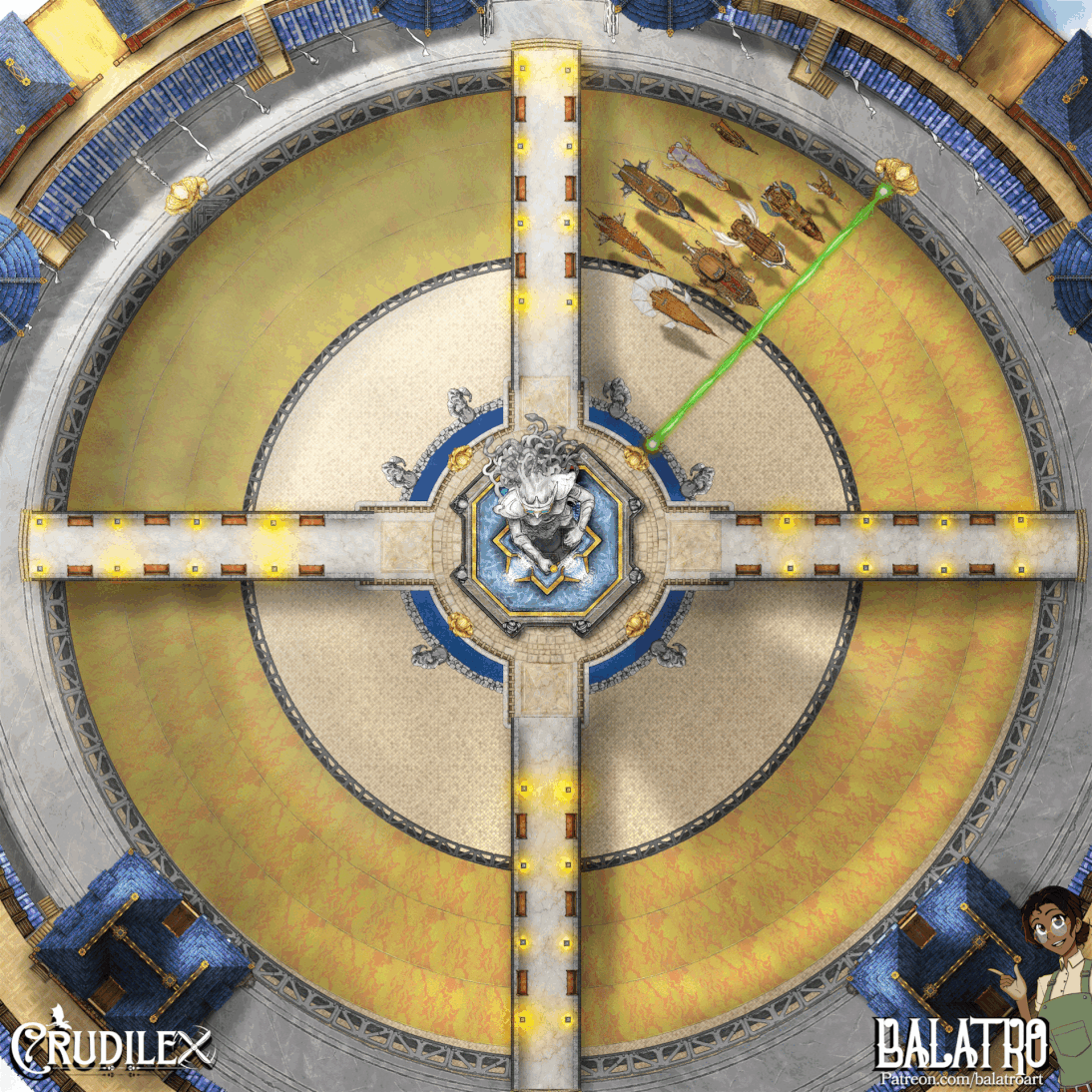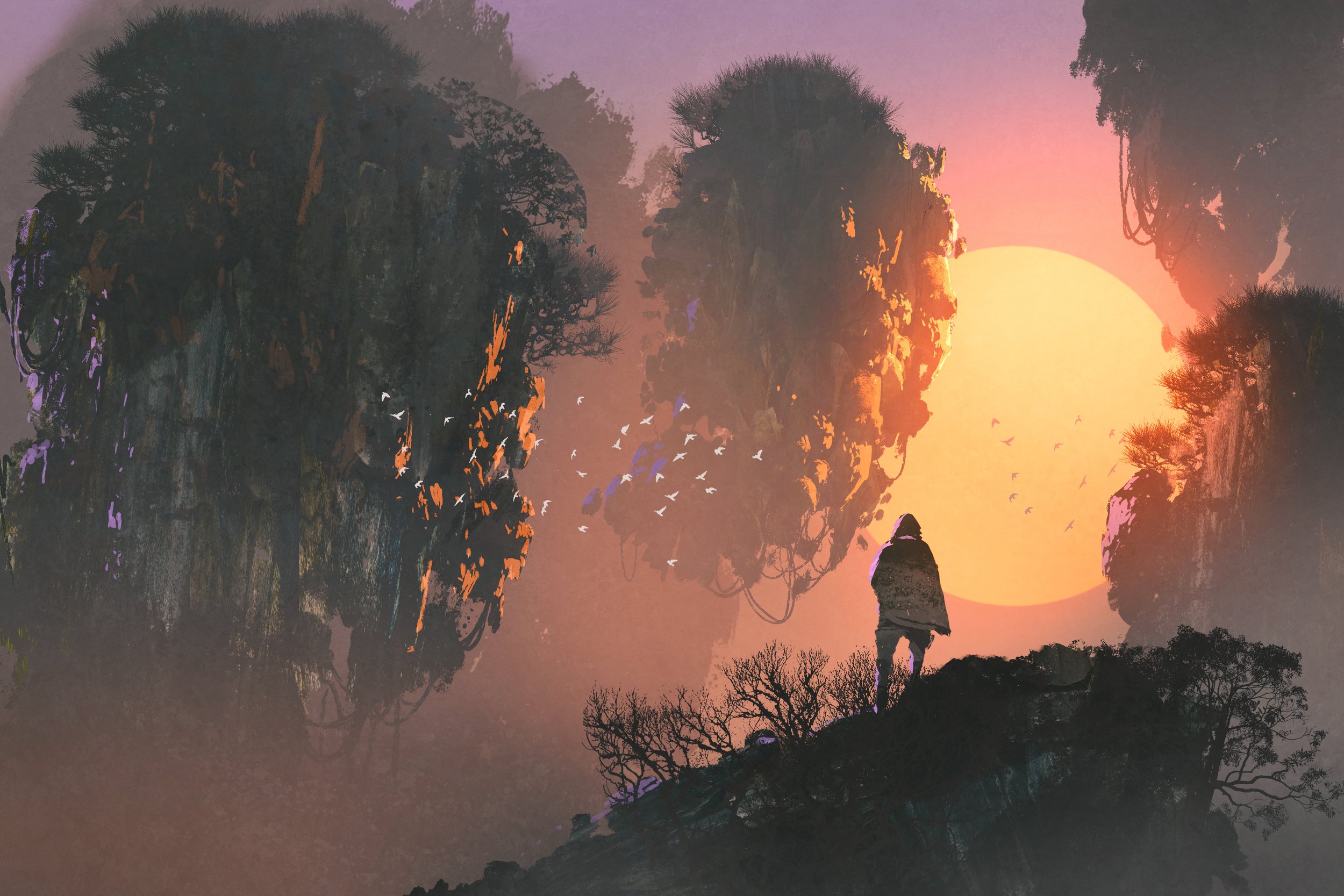
The Motes
Made up of floating islands, clustered together and drifting through a cloudy sky on a backdrop of vast dusty purple dunes below. This strange region owes its existence to Irai—a mysterious, magical substance resembling a purple quartz crystals that defy gravity, hovering in place, immovable by any mundane means. Irai’s properties change depending on the substances it interacts with. Many of its effects remain unknown, but the few that have been discovered have already reshaped technology in Crudilex in dramatic ways.
The Motes are home to perhaps the largest known reserves of Irai. Each floating island contains a massive geode of the crystal at its core, keeping it suspended in the air. Nearly all of Grand Nostridan’s power comes from mining and exploring the Motes. Still, this region remains a wild frontier. explorers and aeronauts call the Motes home, carving out lives aboard their airships amongst the floating lands.
No day in the Motes is easy—but for those willing to risk it, the rewards are great.
Battlemaps set in this location
Deacon Prison
Constructed of the extremely rare and expensive alloy, Black Iron, Deacon Prison is considered one of the most fortified strongholds in all of Crudilex. A massive iron gate guards its inner docks, which serve as the only entrance Reachable only by cable car or airship. More than one thousand cannons, harpoons, and Tho-Cell weapons line its walls.No one has ever escaped the Deacon family’s clutches once imprisoned here.
Deacon Prison houses a private fleet that serves as a secondary defense for Cirrus-on-High. The fleet remains docked within, always ready to repel any foolish assault. What happens inside remains a mystery. Few prisoners ever leave. Those who do tell wildly conflicting tales, though all speak of dark Arcana experiments performed on death-row inmates. Some claim memory alteration and mind control. The prison also serves as the headquarters of the Deacon family mafia, one of Nostridan’s six infamous criminal syndicates.
Burning Blue
a small nation’s worth of mana batteries and Tho-Coast gyromanics, it is equipped with an experimental device that allows it to siphon power directly from the Soulgate—the energy field at the edge of the atmosphere that shields Crudilex from the roiling chaos beyond. Rising to that airless altitude, into the cold, thin, swirling atmosphere of the upper dome, Burning Blue can deploy its siphon attaching to the soulgate and theoretically repower itself indefinitely.
Ironclad vagabond port-class airship
Burning Blue is one of only three of its kind and the only one still in active service. Of its sibling airships, Halls of Air crashed during its test launch and was later dismantled in a hangar at Falstead airfield. The other, Face of God, has never flown, having lost funding at the beginning of the Federalist-Dawnfire War.
Burning Blue is a mile-long airship with an onboard plane and skiff hangar, as well as ascent and descent lifts. It is easily the largest and heaviest airship ever built and serves as a kind of flying city for the Aeronauts—a culture of skyfaring engineers who explore and master the skies of Crudilex. Aeronauts exist across the world, but the art of taking to the sky was born in the Motes. Among the aarakocra and floating islands, the first flying machines were tested and perfected.
Burning Blue has a secret that allows it to remain airborne. In addition to
Flakwind
Originally erected as a forward bastion between Gouldel and Roa during a time of conflict and dispute over control of the Motes, Flakwind is a military base built both atop and within the mote itself. At its center stands a tall tower armed with a massive, rotating anti-airship flak cannon. Though the war that prompted its construction never came to pass, the cannon has been used to defend mining and merchant airships from frequent skypirate attacks.
The island has since evolved into a common Aeronaut rear base and trade port. Its strategic location and fortified structures make it a reliable place to find capable crew, comfortable beds, and a strong drink. Known for its opportunities, Flakwind draws many Aeronauts who linger here while searching for a ship in need of hands.
Roian Mining Operation
This is the primary Roian mining effort in the Motes. Massive Rendcresk-class skiffs regularly ferry loads of Irai crystals and equipment between the Motes and Roa. Their skyborne voyages are a common sight in the southern skies, and their cargo is both valuable and heavily guarded. As the Irai crystals are extracted, the motes begin to weaken and shatter. These floating islands owe their defiance of gravity to the crystals, and without them, they become unstable. Even smaller fragments can hold hundreds of tons of stone, and a few slivers left behind can generate satellite clasts. Over time, this creates hazardous airborne reefs and broken clast motes that make airship travel extremely difficult and dangerous.
Despite the risks, mining has been practiced here for a very long time. Roa takes great care to collect and harvest even the smallest fragments, slowly chipping away at the mote that floats above their city.
Crownroost
Home to the eastern aarakocra, Crownroost is a fiercely guarded highland where these skyborn people tend to their eggs and hatchlings. Irai crystals play a central role in their religious and cultural ceremonies, believed to carry both spiritual and elemental significance. Aarakocra society is deeply structured around altitude. Those of higher status live on the upper motes, and their leader, known as the Star Seeker, resides on Crownroost itself.
To earn the right to ascend and live higher, aarakocra compete in a sport called Vaz-Am—a high-stakes blend of racing and ball game. The sport involves navigating dangerous environmental obstacles and flying through monster-infested lairs. Those who fail to prove themselves in Vaz-Am often fall in social standing, and many eventually turn to airship piracy as a means of survival.
Crownroost is the highest of all the Motes, soaring nearly three miles above the Undermote. The air here is thin and frigid, inhospitable to most forms of life. Yet the aarakocra thrive, living a tribal, communal existence shaped by the skies.
Highwind
Along the eastern extreme of the Motes lies a region of violent torrents and air currents known as the Highwind. The swirling gales strike out so regularly and forcefully that only the fastest, most expertly piloted airships can pass through without serious difficulty. Anything not securely fastened on your deck is swept into the hungry sky. And that will be the least of your troubles, sails left open in the wind are torn to shreds, ropes with any slack will rattle their rigging to pieces, and even emergency gliders offer little hope. If an aeronaut falls overboard, the wind will seize them like a predator, flinging them into the motes or smashing them against the Soulgate.
Only those who have spent their lives in the Highwind know how to navigate it with any kind of safety. The power of its gales is undeniable, but there is a natural pattern to it. The spiral is caused by a confluence between the Manderwind and the Soulgate, caught in endless motion like an uncorked bottle. These rhythms can be learned and worked into mussel memory. and that is exactly what the aarakocra of Crownroost have done. Through generations of adaptation and practice, they have become the greatest fast flyers and aerial acrobats in the world. Even the least among them would be considered an ace by any other measure.
Jatterak
This large, shattered mote is home to the Imps. Split down the middle during the early days of aeronautics, the island was one of the first attempts to mine a mote for its Irai. The result was a complete disaster—many lives were lost, and Irai mining was banned for nearly a decade by Roa.
The island was abandoned. The exposed geode of Irai remained, tempting miners for years. Only those willing to smuggle and mine illegally dared extract what they could before the Bluecoats would chase them off. Eventually, the Imps of the Forsaken began using the island as a home base, building squats and hovels into its broken face. The Bluecoats, unwilling to stir conflict with the Syndicate, left them alone.
Even after mining was legalized again during the Roa-Stai War, the island remained in the hands of the Imps and the Forsaken. Today, the giant geode has become a symbol of their self-governance. The Imps decorate their clothing with jewelry made from its Irai, wearing it as the emblem of their autonomy.
Air Pirate Radio
“Nouncer” is a wanted criminal and former Royalist radio technician from the Colloran Civil War, turned airship pirate. He and his crew decided to become deserters, flying away in their stolen frigate; they now spend their days fleeing both their old Royalist allies—who continue to fight after the war with fanatical zeal—and the Nostridinian Bluecoats, who are determined to shut down their illegal broadcast.
Recently, they came under attack by the creature that dwells in the Vogchoga Jungle. In their escape, they emerged on the southern side of the Eios Reef, where they have been trapped for several months. According to their broadcasts, however, morale remains high. Many of the wrecks scattered throughout the reef have had well-stocked kitchens to salvage, and their transmissions suggest that the crew’s spirits are far from broken.
Vogchoga, and The Flying Tyrant
Crudilex is home to many legendary monsters, most of which stalk the untamed wilds of the Northlend or out beyond the plains in unexplored reaches away from humans. But few are as infamous as the beast of Vogchoga, the Flying Tyrant. This colossal, ape-like beast can leap hundreds of feet between motes and is powerful enough to drag entire airships from the sky. Its arrival is always preceded by a cloud of strange, swallow-like birds that swarm in dense flocks around it—creatures seen nowhere else in the world and always with the beast of Vogchoga.
The beast of Vogchoga is not purely animalistic. In fact, its attacks beyond its home mote appear deliberate. These targeted strikes consistently prevent any large settlement from establishing a foothold in the southern Motes around the floating jungle island. It keeps the motes wild, no matter how hard the aeronauts work to tame it. For this reason, it earned its dreaded title: the Flying Tyrant.
Eois Reef Light Station
The Eois Reef is a belt cluster of tiny motes called clasts that individually could easily bounce off the hull of any ironclad flying through. However, together they present a very real and dangerous threat. These clast reefs are completely impenetrable to skiffs and blimps. Even a single broken clast catching on a sharp edge is enough to breach a ship’s hull. Once inside, the damage can be immense, as the ship continues moving while the clast remains fixed in place.
The reef is formed from clusters of dead motes breaking and falling away from their whole after the mote was mined for its Irai geode. Many contain only the smallest amounts of Irai crystal to keep
them aloft, defying gravity. Over time, the rock around these crystals erodes due to wind and rain, crumbling to join the pink dust that forms the Undermote Desert below. Along the easternmost portion of the reef stands a light station, warning ships to steer clear during darkness when even the most secure vessels risk colliding with one or more clasts.
Deepsky
Deepsky is the area down in the low-motes of the south eastern cluster. Before venturing off into the dust wind barrens there are wild, dangerous winds that pose a threat to anyone who managed to fly beyond the Eios Reef. A sudden crosswind blowing along the side of a captain's airship is enough to send them into a roll, or forcing them to land. This has been the end for many crews in the area who fly through, often after taking hull damage from the reef, the beast of Vogchoga or both.
The shattered remains of frigates litter the dust caked lower motes. Airship shipwrecks crashed and giant depleted deadmotes have become the place where desperate aeronaut scavengers and cast outs live. Picking over the remains like crabs over a dead whale.
Deadmote
Mined almost to extinction, this mote’s Irai geode is nearly gone. It hangs precariously in the air, with large clasts regularly crumbling and falling into the hungry sky. The mote itself is barren, composed of grey, lifeless rock. Jagged, shattered pieces of slate shoot upward in a halo of broken clast motes, making the entire island dangerous for airships to land upon. The Desolate floating island is as hopeless as the aeronauts who are forced down on it. Cursed, blasted, and eager to crumble into dust to join with the barrens below.
Dustwind Barrens
Beyond the motes to the southeast, the winds blow sand and spent powdered irai, spreading as far as the eye can see into the horizon. Nothing grows here, and only the occasional mote can be spotted in the sky; more frequently, huge jagged boulders poke out of the dunes like knives. The geodes at their cores have spent their internal energies and plummeted from the sky.
Nothing thrives in the Barrens—no normal desert life can gain a foothold here. The further one journeys into the Dustwind Barrens, the rarer life becomes. At a certain depth, those who venture in find that reality itself seems to shift into something supernatural.
The Barrens drain life away, slowly pulling vital energies from any living thing that ventures within. After a point, mortals cannot tread further without constant healing magic to negate the strange effects. It is said that something waits out there, but to know for sure seems impossible. An old necromancer once known as Regent Woodrow has taken residence at the absolute edge of the Barrens, seeking whatever secrets lie undiscovered in the purple dunes.



